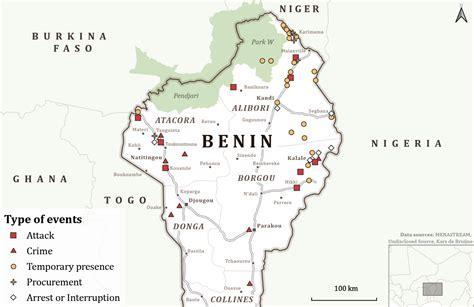
Hostage to violent extremism Kidnapping in northern Benin
In northern Benin, before 2022 there were only two recorded incidents of kidnapping (as a form of political violence, as opposed to for ransom and purely as a criminal act). The kidnapping of two French nationals (and the murder of a park guide) in 2019 marked a turning point in the evolution of violent extremism in the country, as the first attack by a VEO on Beninese territory.
In 2023, with VEOs having expanded from the Sahelian states of Mali, Burkina Faso and Niger and cemented their presence in Benin’s Atacora and Alibori departments, recorded kidnapping incidents escalated dramatically again. This rise in kidnapping mirrors a sharp increase in violence more broadly in northern Benin (see Chart 1), with an increasing proportion attributed to suspected VEOs. Violence has also increasingly targeted civilians: civilian fatalities at the hands of suspected VEOs increased more than threefold between 2022 and 2023.
The main armed group present in these two most northern regions of Benin, and thus the focus of this study, is Jama’at Nasr al-Islam wal Muslimin (JNIM). The presence of Islamic State Sahel (IS Sahel) has been reported at the border with Niger, in Malanville and Karimama communes, and while an ongoing presence is still likely, its reach is far more limited compared to JNIM.
Since 2021, and more extensively from 2022, JNIM has been infiltrating new communities in northern Benin by building alliances (often by force) and intimidating key personalities. Kidnapping is an important tool used by JNIM to achieve this, replicating tactics found across the Sahel. In these preliminary phases of penetration, they need to gather information and establish themselves as the new legitimate actor, while facing a significant amount of opposition.
A spike in kidnappings has repeatedly operated as an indicator of early-stage infiltration by JNIM into new, unfamiliar territories, in which they have not yet consolidated their presence and influence. While violent attacks are the most visible form of VEO activity, tracking and examining trends in kidnapping can provide a complementary data set for analysing the evolution of extremist armed group influence.
Kidnappings accompanying expansion is a consistent element of the JNIM playbook. This echoes past research from the Global Initiative Against Transnational Organized Crime (GI-TOC) in the region, which has identified kidnappings as an accelerant criminal economy, meaning that it has a self-reinforcing relationship with instability and plays a prominent role in driving conflict throughout West Africa.
JNIM and IS Sahel are not the only actors in the kidnapping business, and there is a distinct type of abduction, perpetrated by bandits or otherwise unidentified armed groups, that primarily targets wealthy individuals. Crucially, these almost always result in a ransom request, which is not the case with kidnappings by VEOs. These profit-motivated kidnappings have a longer history in Benin, and have been traced, in small numbers, back to 2016 at least, but largely occur further south in the Borgou and Collines departments (although some cases have been reported in Alibori, again, mostly on or near the Nigerian border). While this (primarily criminal) species of kidnapping continues across the country to this day, VEOs are now by far the most common actors behind kidnappings in northern Benin.
With some notable exceptions, VEOs do not tend to engage in kidnap for ransom of locals. Broadly speaking, financial considerations are not driving the spike in kidnappings that Benin has experienced since 2021. Instead, this research identifies four main types of kidnapping used by VEOs – forced recruitment, intelligence gathering, as punishment and to intimidate – all of which are closely linked to conflict dynamics and territorial expansion. Far from being an example of random violence, kidnapping is used by VEOs in large part to further their goals of displacing the state from an area, with the long-term aim of building legitimacy among local communities. And yet across northern Benin, kidnapping (together with cattle rustling) is among the illicit economies with the most destabilizing effect on communities.
This report will first set out the backdrop for this surge in kidnapping, namely the spread of VEO operations from the Sahel region southward into several of the coastal states on the Gulf of Guinea. It will then look at each type separately and, drawing on analysis of similar trajectories elsewhere in the region, highlight the ways in which kidnapping is being used as a strategic tool by VEOs in their expansion into northern Benin. A brief exploration of the phenomenon of kidnap for ransom is presented thereafter.
The report concludes with an overview of the responses taken thus far, before setting out recommendations for national and regional policymakers.
Source » globalinitiative.net





